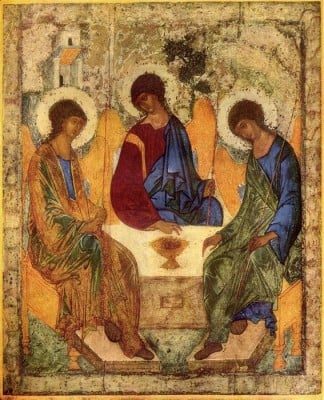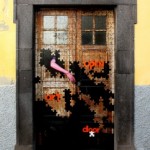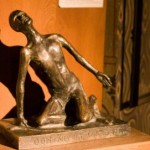St. Patrick’s hymn to it, written on his death bed, sings of images of earth and heaven, sea and wind, Christ in all:
I bind unto myself today the strong name of the Trinity, by invocation of the same, the Three in One, the One in Three.
I bind unto myself today, the virtues of the starlit heaven, the glorious sun’s life-giving ray, the whiteness of the moon at even, the flashing of the lightning free, the whirling wind’s tempestuous shocks, the stable earth, the deep salt sea, around the old appointed rocks.
Christ beneath me, Christ above me, Christ in quiet, Christ in danger, Christ in hearts of all that love me, Christ in mouth of friend and stranger. (words from St. Patrick’s Breastplate)
Emily Dickinson invoked the Bee, the Butterfly and the Breeze. The ancient Celts invoked a trinity of birds: Wren, Raven, and Wild Goose, each known for different qualities of compassion, courage, character.
The Celts also invoked a female trinity, virgin, bride, and crone, each with powers for regeneration and fertility, and they were beseeched in the blessings of fields, hearths, marriage beds.
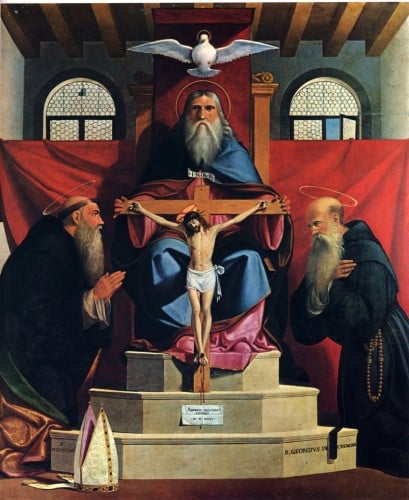 The male Christian Trinity is so repeatedly invoked liturgically that it loses its resonance, its sense of wonder or invitation in its names, its relations. It has become a salute, all about marshalling obedience, and not at all about walking in mystery.
The male Christian Trinity is so repeatedly invoked liturgically that it loses its resonance, its sense of wonder or invitation in its names, its relations. It has become a salute, all about marshalling obedience, and not at all about walking in mystery.
Trinity intends to convey a dynamic relationship, full of the flashing lightning, whirling wind, deep salt sea that St. Patrick named, elemental wonders Jesus also cherished and used descriptively for the relationship of God and people: sheltering tree, wild sower, extravagant giver offering tangible love. None of these qualities is essentially male, nor essentially female. And Jesus, who was male, is fully identified with the feminine Sophia tradition in Judaism, and with women he dearly loved in his life.
The Nicene Creed, that 4th century pledge of allegiance, makes Trinity into a hierarchy: Father, begotten Son, and Holy Ghost begotten of them both. Or not.
Theological wars have been fought, and churches divided, over whether the Spirit proceeds from the Father alone, or from the Father and the Son, whether you should say ‘and the son’ when reciting the creed, or not.
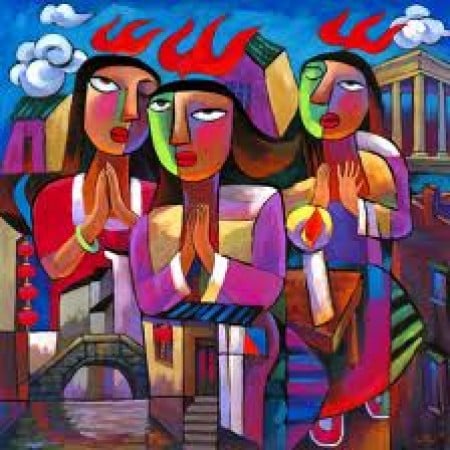 My Episcopalian grandmother, who was a Congregational missionary teacher before her marriage into the Episcopal world, had the custom of omitting the first two words (I believe) when saying the creed, and she taught us all to do the same, leaving her husband rolling his eyes and leaving our consciences free to become familiar with concepts we might or might not own, while at the same time, participating. And I owe to her cheerful dissent-with-support, that I’ve kept on thinking about the family differences and connections between generations of people and the entire generative garden of life in which we live.
My Episcopalian grandmother, who was a Congregational missionary teacher before her marriage into the Episcopal world, had the custom of omitting the first two words (I believe) when saying the creed, and she taught us all to do the same, leaving her husband rolling his eyes and leaving our consciences free to become familiar with concepts we might or might not own, while at the same time, participating. And I owe to her cheerful dissent-with-support, that I’ve kept on thinking about the family differences and connections between generations of people and the entire generative garden of life in which we live.
 The first reading for Trinity Sunday is the Genesis account of creation, in which the Spirit precedes the Father, and of course also the Son. The Spirit hovers over the face of the waters, Genesis says, even before the first Word of Creation is spoken. And so the Spirit precedes the division of sexes, and, like God, is both male and female.
The first reading for Trinity Sunday is the Genesis account of creation, in which the Spirit precedes the Father, and of course also the Son. The Spirit hovers over the face of the waters, Genesis says, even before the first Word of Creation is spoken. And so the Spirit precedes the division of sexes, and, like God, is both male and female.
And so, the Creator proceeds in the companionship of the Spirit, in fact, God becomes the Creator with the Spirit’s aid, and is therefore younger, at least in that role, than the Spirit. The ladder turns upside down . . . and yet, Jesus promises we will know the Spirit after he departs, and it is written that he has known the Spirit since before he was born. So he proceeds from the Spirit, and precedes the Creation and its division into male and female.
We, too, will know the Spirit, Jesus promises, who will be sent to us by God, and Spirit, all the gospels say, was already here blessing Jesus at his baptism. We, too, are born of the Spirit, in our baptisms, with each swallow of the cup of forgiveness and the bread of life, and in each unexpected raising of our hearts from brokenness. And Jesus has promised and Paul repeats that we, too, will enter eternal life in which there is neither male nor female.
 Paul, whose words often become the bedrock of authoritarian theology, in fact preached eloquently on the primacy of the Spirit, and the life-giving dynamic possible in the relationship of people and God:
Paul, whose words often become the bedrock of authoritarian theology, in fact preached eloquently on the primacy of the Spirit, and the life-giving dynamic possible in the relationship of people and God:
The God who made the world and everything in it, does not live in shrines made by human hands, (but) gives to all mortals life and breath and all things. He made all nations to inhabit the whole earth, so that they would search for God and perhaps grope for him and find him—though indeed he is not far from each one of us. For ‘In him we live and move and have our being’; as even some of your own poets have said, ‘For we too are his offspring.’ Since we are God’s offspring, we ought not to think that the deity is like gold, or silver, or stone, an image formed by the art and imagination of mortals.(Acts 17)
The Nicene Creed is an image carved in words of stone, that are far from most of our hearts. Yet the relationship of the Spirit, the great Gate into the green pasture of life with God, remains the power of Trinity, inviting us into a place where we may live and move and have our being in a mystical time and an eternal truth that can be named and renamed as we immerse ourselves in the deep waters, the fresh winds, the stable rocks, the burgeoning life that offers us, even in death, a new beginning.
Morning, noon, and night – above, below and within – in birth, life, and death – the grace, mercy and peace – of God who is never either-or, but always for us, with us, and in us, enfold us in blessing.
_________________________________________________________
Illustrations:
1. Trinity. Rublev, Andrei (Saint). 1400. Moscow, Russia. Vanderbilt Divinity School Library, Art in the Christian Tradition.
2. Trinity with Worshippers. Previtali, Andrea, 1517. Santa Maria de la Conzolazione. Vanderbilt Divinity School Library, Art in the Christian Tradition.
3. Pentecost. He Qi. Nanjing, China. Vanderbilt Divinity School Library, Art in the Christian Tradition.
4. Creation – Day 1. Mid 12th c. Cappella Palatina di Palermo. Palermo, Italy. Vanderbilt Divinity School Library, Art in the Christian Tradition.
5. Three Angel Visitors and Abraham. Cathedral di san Vitale. Ravenna, Italy.
Vanderbilt Divinity School Library, Art in the Christian Tradition.

